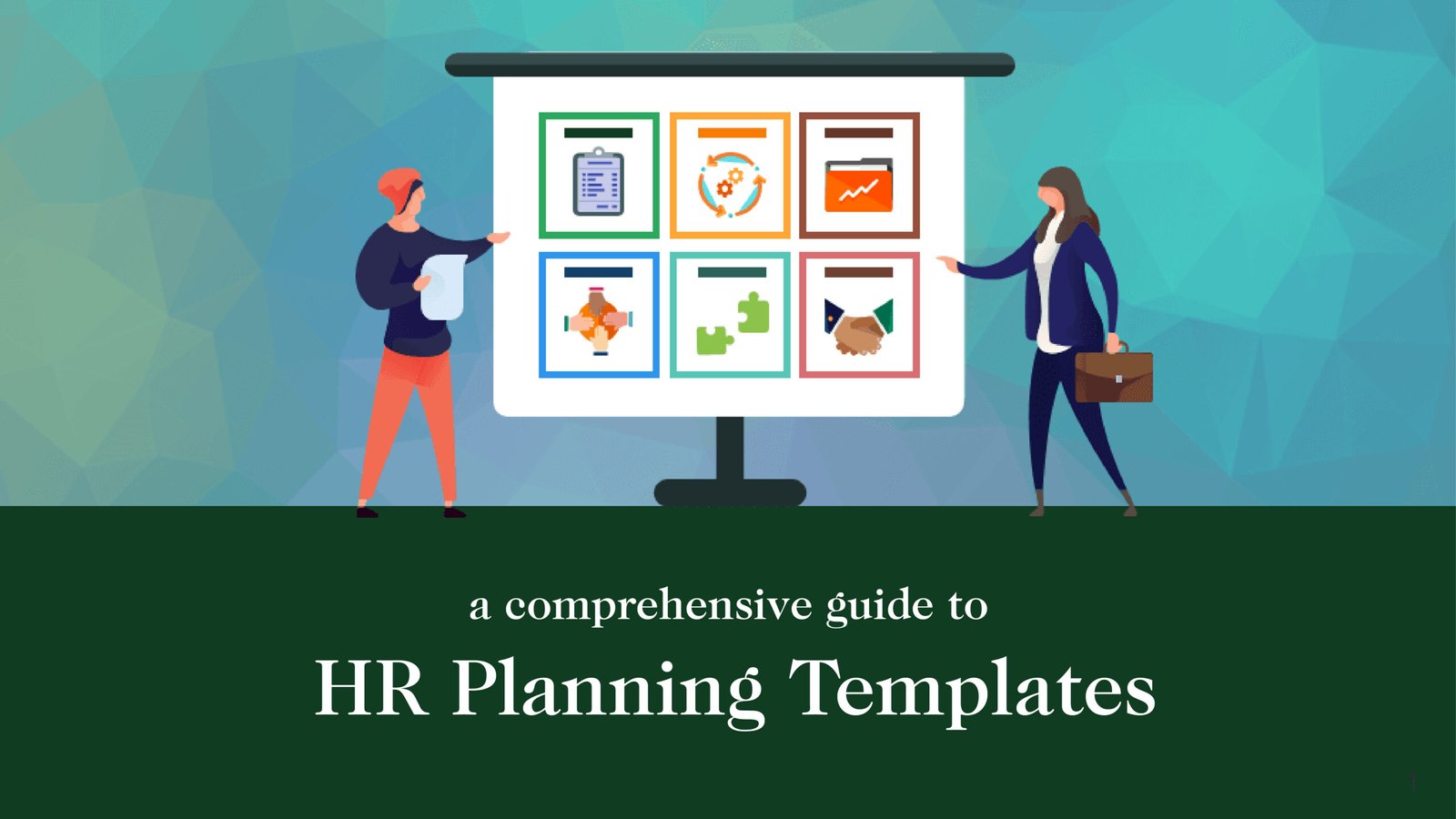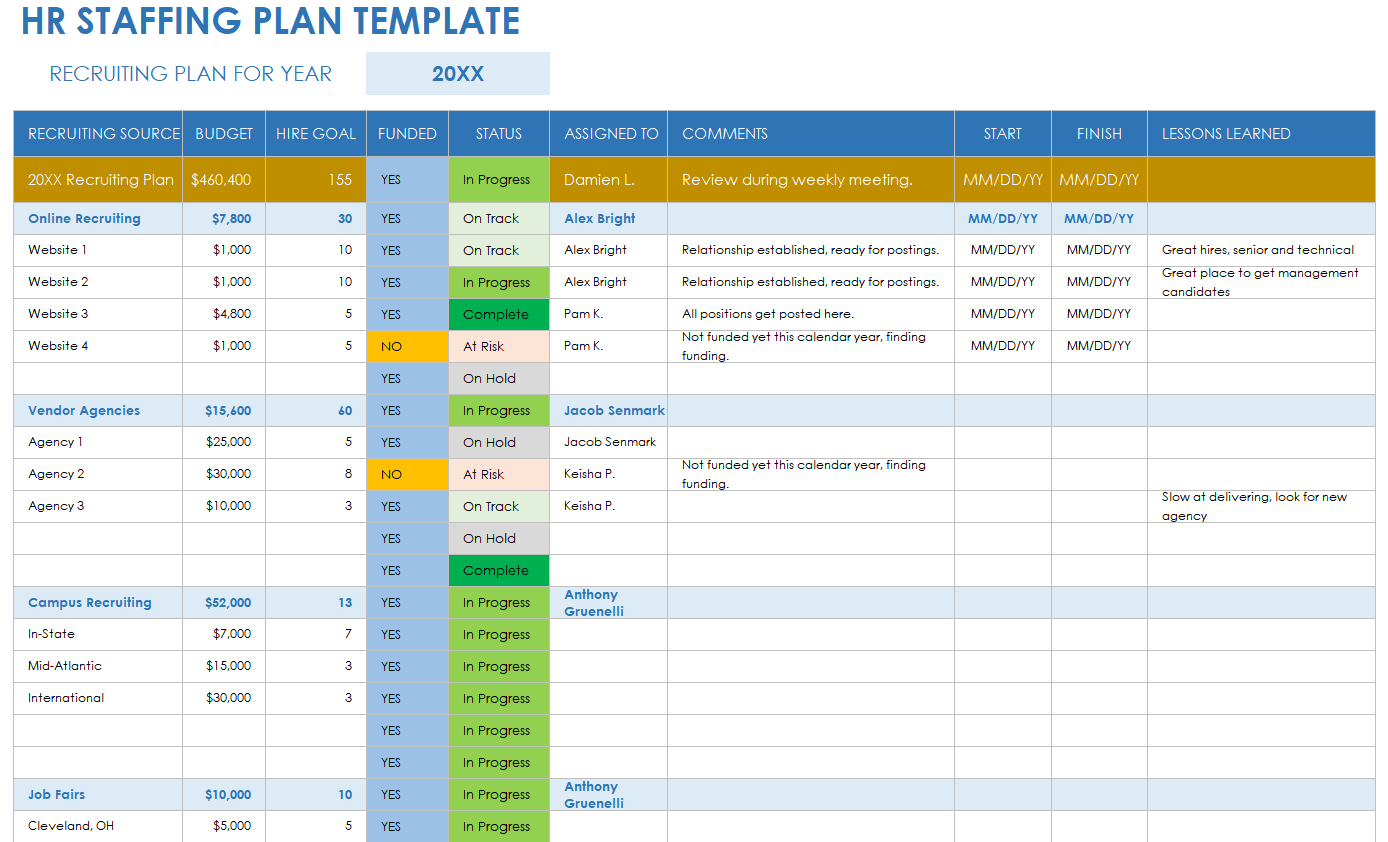Human Resources (HR) planning is crucial for any organization, as it ensures that the right people are in the right roles at the right time to achieve business objectives. HR Plan Templates serve as a blueprint for HR managers to strategize, implement, and evaluate HR practices effectively
Importance of HR Planning:
Human Resources (HR) planning is vital for several reasons:
Anticipating and Meeting Organizational Needs: HR planning helps anticipate future workforce requirements based on organizational goals and changes in the business environment. By understanding staffing needs in advance, HR can ensure that the right talent is available when needed.
Talent Acquisition and Retention: Effective HR planning enables organizations to attract, recruit, and retain top talent. It helps identify the skills and competencies required for various roles, allowing HR to develop recruitment strategies to fill those positions.
Optimal Resource Utilization: HR planning ensures that resources, including human capital, are utilized efficiently. It helps prevent understaffing or overstaffing situations, optimizing workforce productivity and cost-effectiveness.
Succession Planning and Talent Development: HR planning involves identifying and developing future leaders within the organization. By implementing succession planning initiatives, HR ensures a smooth transition when key positions become vacant. Additionally, it facilitates the development of employee skills through training and career development programs.
Adapting to Change: In today’s dynamic business environment, organizations frequently face changes such as technological advancements, market shifts, or regulatory requirements. HR planning allows organizations to adapt to these changes by adjusting their workforce strategies accordingly.
Related Article: 10 Tips To Build An Employee Task Tracker Template – PMITOOLS

How can HR Planning uplift our business?
HR planning can uplift a business in several ways:
1. Aligning Human Capital with Business Objectives: Effective HR planning ensures that the organization has the right people in the right positions to achieve its strategic goals. By aligning HR strategies with business objectives, HR helps maximize employee contributions to the company’s success.
2. Optimizing Workforce Productivity: HR planning helps prevent under- or over-staffing situations, ensuring optimal workforce productivity. By accurately forecasting staffing needs, HR can avoid costly inefficiencies and ensure that resources are utilized efficiently.
3. Attracting and Retaining Top Talent: A well-developed HR plan includes strategies for attracting, recruiting, and retaining top talent. By offering competitive compensation, benefits, and career development opportunities, HR can attract skilled employees who are committed to the organization’s success.
4. Fostering Employee Engagement: Engaged employees are more productive, innovative, and committed to their work. HR planning includes initiatives to enhance employee engagement, such as training and development programs, recognition and rewards, and opportunities for career advancement.
Related Article: Top 3 Employee Performance Report Templates – PMITOOLS
5. Supporting Organizational Growth: As businesses grow and evolve, their HR needs change accordingly. HR planning anticipates future workforce requirements and develops strategies to support organizational growth, whether through expansion into new markets, launching new products/services, or scaling operations.
6. Enhancing Organizational Agility: In today’s fast-paced business environment, agility is essential for success. HR planning enables organizations to adapt quickly to changes in the market, technology, or regulatory environment by adjusting staffing levels, skills, and competencies as needed.
7. Improving Decision-Making: HR planning provides valuable data and insights that support informed decision-making. By analyzing workforce trends, skills gaps, and performance metrics, HR helps leaders make strategic decisions that drive business success.
8. Cultivating a Positive Workplace Culture: A strong workplace culture fosters teamwork, innovation, and employee satisfaction. HR planning includes initiatives to promote a positive culture, such as diversity and inclusion programs, employee wellness initiatives, and effective communication strategies.
10. Building a Strong Employer Brand: A positive employer brand attracts top talent and enhances the organization’s reputation in the marketplace. HR planning includes initiatives to build and maintain a strong employer brand, such as employer branding campaigns, employee referral programs, and positive employee experiences.
Related Article: PMO Dashboard Template – PMITOOLS

1. Understand Organizational Goals: Begin by aligning your HR plan with the organization’s strategic objectives. Understanding the business’s long-term vision and goals will help tailor HR strategies to support them effectively.
2. Conduct a Comprehensive Analysis: Perform a thorough assessment of the organization’s current state, including its structure, workforce demographics, and culture. Conduct SWOT analysis to identify internal strengths and weaknesses, as well as external opportunities and threats.
3. Involve Key Stakeholders: Collaboration with key stakeholders, including department heads, managers, and employees, is crucial. Their input will provide valuable insights into workforce needs and priorities.
4. Define Clear Objectives: Clearly define the objectives of your HR plan, ensuring they are specific, measurable, achievable, relevant, and time-bound (SMART). These objectives will guide your HR strategies and initiatives.
5. Tailor Strategies to Needs: Develop HR strategies that address the identified needs and objectives. This may include recruitment and selection, training and development, performance management, employee relations, and compensation and benefits.
Related Article: 3 Tips To Create Cost Management Plan Template | PMITOOLS
6. Ensure Flexibility: Your HR plan should be flexible enough to adapt to changing business needs and external factors. Build in mechanisms for periodic review and adjustment as necessary.
7. Consider Diversity and Inclusion: Incorporate diversity and inclusion initiatives into your HR plan to ensure a diverse and equitable workplace. Implement strategies to attract, retain, and develop a diverse workforce.
8. Budget Appropriately: Allocate resources effectively to support your HR strategies. Consider budget constraints and prioritize initiatives based on their impact on organizational goals.
9. Establish Metrics for Evaluation: Define key performance indicators (KPIs) to measure the success of your HR plan. These metrics should align with your objectives and provide meaningful insights into the effectiveness of HR initiatives.
10. Communicate and Engage: Ensure effective communication and engagement with employees throughout the HR planning process. Transparency and involvement will foster buy-in and support for HR initiatives.
11. Review and Revise Regularly: Regularly review and revise your HR plan to ensure it remains relevant and effective. Solicit feedback from stakeholders and adjust strategies as needed to address changing priorities or challenges.
For HR Management Templates: HR Management Template (Strategy, Performance) Excel (ucube.biz)
Top 3 HR Plan Templates:
SHRM HR Strategic Plan Template:
- Comprehensive template offered by the Society for Human Resource Management (SHRM).
- Covers all aspects of HR planning, including workforce planning, talent acquisition, performance management, and diversity and inclusion.
- Customizable and aligns with SHRM’s competency model.
- Provides guidance for developing strategic HR initiatives.
- Suitable for organizations of all sizes and industries.
HR Planning Toolkit by CIPD:
- Offered by the Chartered Institute of Personnel and Development (CIPD).
- Provides templates and guidance for various HR planning aspects, such as workforce planning, talent management, and performance management.
- Includes tools for conducting skills audits, forecasting workforce requirements, and developing action plans.
- Designed for organizations to develop effective HR plans tailored to their specific needs.
- Suitable for businesses and HR professionals seeking practical tools and resources.
HR Strategic Plan Template by HR Council for the Nonprofit Sector:
- Tailored for nonprofit organizations by the HR Council for the Nonprofit Sector.
- Helps nonprofits align HR strategies with their mission and objectives.
- Covers areas such as talent acquisition, performance management, and employee engagement.
- Includes sections for goal-setting, strategy development, and progress monitoring.
- Suitable for nonprofit organizations aiming to develop strategic HR plans that support their unique missions.
Related Article: Strategic human resource planning – Wikipedia
Conclusion:
In short, HR Plan Templates are the valuable tools for HR professionals to develop strategic initiatives aligned with organizational goals. By using HR plan templates, organizations can ensure consistency, efficiency, and effectiveness in their HR practices, ultimately leading to a more engaged workforce and better business outcomes.

